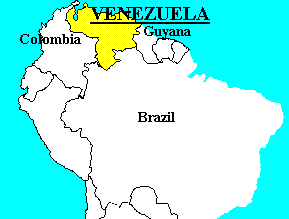
Return to * Top Ten *RIC Main Page * Background Info
Venezuela
Background Information

Basic Indicators
| Population | 21.3 million |
| Pop. growth | 2.22% p.a. |
| Land Area | 882,050 sq km |
| GNP per capita | 2,760 current US$ |
| Life expectancy | 72.10 years |
ENVIRONMENT
The country comprises three main regions. In the north, the Andes extend for about 1,000 km along the Caribbean coast, with other mountain chains in the East, and high mountains to the south. The central Orinoco Plains are a livestock farming area. In the southeast, highlands of ancient rock and sandstone extend to the borders with Brazil and Guyana, forming Venezuelan Guyana. It is a sparsely inhabited area with thick forests, savannas, rivers, and some peculiar features: the two highest waterfalls in the world, the "tepuyes" or plateau mountains, and the rare Sarisarinama depths. Most of the population lives in the hilly north. The oil-rich Maracaibo lowlands and Gulf of Paria are on the coast. The country produces oil, iron ore, manganese, bauxite, tungsten and chrome. Among the countrys most important environmental problems are deforestation and the degradation of the soil. In addition, the lack of sewage treatment facilities in the main urban and industrial centers has increased pollution in the country's rivers and the Caribbean Sea.
SOCIETY
Peoples: Venezuelans come from the integration of indigenous peoples, Afro-Caribbeans and European settlers. Today, indigenous peoples and Afro-Caribbeans each account for less than 7% of the population. In recent times, Venezuela has received more immigrants than any other South American country. Religions: Mainly Catholic. Languages: Spanish, official and predominant; 25 native languages are spoken. Political Parties: Democratic Action (AD), member of the Socialist International; the Social Christian Party (COPEI), a member of the Christian Democrat International; the Movement To Socialism (MAS), founded in 1970; Radical Cause; Convergence, created in 1993 by Christian Democratic splinter groups; the Peoples Electoral Movement (MEP); the Venezuelan Communist Party (PCV); and the New Democratic Generation, linked to the Liberal International. Social Organizations: The Venezuelan Confederation of Workers (CTV) is the main trade union, and is controlled by AD. There are other trade unions which are clearly linked to political parties.
THE STATE
Official Name: República de Venezuela. Administrative divisions: 21 states with partial autonomy (including the Federal District), 2 Federal territories. Capital: Caracas, 4,000,000 inhab. (1990). Other cities: Maracaibo 1,249,670 inhab.; Valencia 903,621 inhab. (1990). Government: Rafael Caldera, president since February 2, 1994. Presidential system, congress with Chamber of Deputies and Senate (199 and 53 members respectively). National Holiday: July 5, Independence Day (1811). Armed Forces: 79,000, including 18,000 conscripts (1994). Paramilitaries: Cooperation Army, 23,000.
Source: World Guide 1997-98, courtesy of New
Internationalist ![]()
Return to * Top Ten *RIC Main Page * Background Info